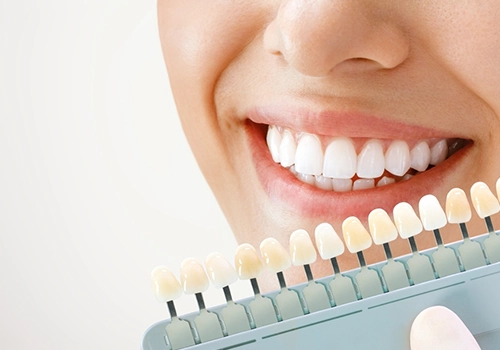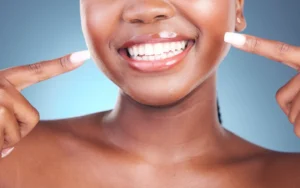What is Tooth Whitening?
A captivating smile adds so much to our facial charm, but as time goes on, various factors can lead to teeth losing their natural brightness and taking on a more yellowish tint. Many of us seek that dazzling Hollywood smile through teeth whitening, a popular choice with numerous procedures promising brighter teeth.
However, it’s crucial to approach this with care, as these methods vary in how effective they are and the costs involved. Opting for quick fixes might seem tempting, but going for a solution that lasts longer can be a more economical choice in the long run.
In-office dental teeth whitening offers a whole array of techniques and variations. As a trusted advisor, Dr. Maadico’s Medical department is here to help you figure out the most suitable and enduring teeth whitening option. Read on to grasp all the information you need if you are considering tooth whitening.
Reasons for Teeth Discoloration
Teeth discoloration refers to the change in the natural color of the teeth, leading to a darker or stained appearance. Discoloration can occur on the surface of the teeth (extrinsic) or within the tooth structure (intrinsic).
1. Extrinsic Staining
Extrinsic staining occurs on the outer surface of the teeth and is often caused by external factors. Common reasons for extrinsic staining include:
- Dietary Habits: Consumption of dark-colored beverages such as coffee, tea, red wine, and cola can contribute to extrinsic staining over time. These beverages contain chromogens, which are pigmented molecules that can adhere to tooth enamel.
- Tobacco Use: Both smoking and smokeless tobacco products contain substances that can stain teeth. Tar and nicotine, for example, can lead to yellow or brown discoloration.
- Poor Oral Hygiene: Inadequate or inconsistent oral hygiene practices can result in the buildup of plaque and tartar on the teeth. Plaque, a soft, sticky film of bacteria, can attract and retain stains from food and beverages.
- Certain Foods: Some foods with strong color pigments, such as berries, beets, and curry, can contribute to extrinsic staining when consumed regularly.
- Chromogenic Bacteria: Certain bacteria in the mouth produce pigments that contribute to staining. These bacteria can thrive in the presence of sugars and starches.
- Environmental Factors: Exposure to environmental factors, such as pollution or metals in water, can contribute to extrinsic staining.

2. Intrinsic Staining
Intrinsic staining refers to discoloration that occurs within the internal structure of the tooth. Unlike extrinsic staining, intrinsic staining is often more challenging to address because it involves changes within the tooth itself. Common reasons for intrinsic staining include:
- Aging: As individuals age, the enamel (outer layer of the tooth) naturally wears down, revealing the underlying dentin, which is yellowish in color. This can result in a gradual intrinsic discoloration.
- Genetics: Genetic factors can influence the thickness and color of tooth enamel. Some individuals may be genetically predisposed to have teeth with a certain level of natural pigmentation.
- Trauma: Injuries or trauma to the teeth, especially during developmental stages, can cause intrinsic discoloration. A blow to the tooth may damage the blood vessels within, leading to the formation of pigments.
- Prenatal and Childhood Exposures: Factors such as exposure to tetracycline antibiotics during tooth development or excessive fluoride intake during childhood can cause intrinsic staining.
- Medical Conditions: Certain medical conditions, such as amelogenesis imperfect (a genetic disorder affecting enamel development) or metabolic disorders, can contribute to intrinsic discoloration.
- Dental Procedures: Some dental treatments, particularly those involving certain materials or procedures like root canal therapy, may lead to intrinsic discoloration over time.
- Systemic Diseases: Diseases that affect the body’s overall health, such as certain liver or kidney disorders, can manifest as changes in tooth color.
What Is Tooth Whitening?
Tooth whitening is a cosmetic dental procedure designed to lighten the color of teeth and remove stains and discoloration. The primary goal is to enhance the overall appearance of the teeth, giving them a whiter look and brightening smiles. There are two main types of tooth whitening: in-office professional whitening and at-home whitening.
1. In-Office Professional Whitening
- This type of tooth whitening is typically performed by a dentist in a dental office.
- Before the whitening procedure, the dentist will conduct a thorough examination of the patient’s teeth and gums to ensure they are in good oral health and suitable for the treatment.
- The dentist will often start by protecting the gums and soft tissues around the teeth with a barrier or a protective gel to minimize the risk of irritation.
- A high-concentration whitening gel, usually containing 15% to 40% hydrogen peroxide, is carefully applied to the teeth. Some systems may use a light or laser to activate the whitening agent, enhancing its effectiveness.
- The whitening agent penetrates the tooth enamel, breaking down stains and discoloration. This process is facilitated by the release of oxygen, which helps to lighten the teeth.

- The dentist monitors the progress and adjusts the treatment as needed to achieve the desired level of whitening.
- In-office whitening typically takes about one to two hours, with noticeable results often achieved in a single session. However, the number of sessions required may vary based on the severity of discoloration and the desired level of whiteness.
Light-Activated Whitening:
This method involves applying high-concentration hydrogen peroxide or carbamide peroxide gel to the teeth and then using a special light source, such as LED, halogen, or laser light, to activate the whitening agent.
Although Light activation such as Zoom Whitening provides quicker results, some dentists prefer non-light-activated systems for their simplicity and reduced risk of heat-related sensitivity.
Internal teeth whitening:
Internal or non-vital bleaching is a dental procedure used to lighten discolored teeth from the inside. This method is typically for teeth that have undergone root canal treatment and have discolored due to changes in the tooth’s internal structure.
- The dentist first checks the tooth’s condition, the cause of discoloration, and the absence of any active infection.
- The tooth is isolated from saliva using a rubber dam to prevent contamination during the procedure.
- A small opening is made in the back of the tooth, providing access to the pulp chamber.
- A whitening agent, often a high-concentration hydrogen peroxide gel, is placed inside the tooth. This gel is left in the tooth for a specified period, during which it works to bleach the discolored dentin from the inside.
- Once the desired level of whitening is achieved, the access opening is sealed with a tooth-colored filling material.
Patients may experience temporary tooth sensitivity during and after the procedure, which usually resolves over time.
Post-Treatment Care
- Patients should refrain from consuming coffee, tea, red wine, and tobacco, immediately after the whitening procedure.
- Dentists may recommend a “white-teeth-friendly” diet, including fruits, vegetables, and dairy.
- Patients should brush their teeth at least twice a day with fluoride toothpaste and floss daily.
- Dentists may recommend specific toothpaste or mouthwash formulated for whitening purposes that help maintain the results of the whitening procedure.

2. At-Home Whitening
At-home tooth bleaching involves the use of whitening products that are provided by a dentist or available over-the-counter. Common at-home tooth whitening products include whitening gels, strips, trays, and toothpaste. These products also contain peroxide-based bleaching agents but are typically less concentrated than those used in professional in-office treatments (3% to 20%).
At-home whitening may take several days to weeks, depending on the specific product and the degree of whitening desired.
Some individuals may also be interested in natural tooth whitening methods such as using baking soda. While these methods are perceived as gentler remedies, they are less powerful than commercial whitening products, and as there are no certain medical instructions for these methods, in some cases they may have abrasive or acidic properties that could potentially harm tooth enamel.
Individuals should consult with their dentist before trying any at-home whitening method, natural or otherwise, to ensure that it is safe and suitable for their oral health.
- Whitening Gels: Typically contain peroxide-based bleaching agents. They are applied evenly and directly to the teeth using a brush or applicator. Whitening gels may come in various concentrations, and some are activated by LED lights for enhanced results.
- Whitening Strips: These are thin, flexible strips coated with a peroxide-based gel. Users place the strips onto their teeth, ensuring good contact. The gel works to whiten the teeth during the recommended wear time, usually around 30 minutes.
- Whitening Trays: These trays are custom-fitted or one-size-fits-all trays that hold whitening gel against the teeth. The tooth bleaching trays are filled with the whitening gel and worn over the teeth for a specified period, allowing the gel to come into contact with the tooth surfaces.
- Whitening Toothpaste: Bleaching toothpaste contains abrasive agents, chemicals, or enzymes to help remove surface stains. Used in the same manner as regular toothpaste, individuals brush their teeth with whitening toothpaste to help reduce surface stains over time.
Tooth Whitening Risks and Side Effects
- Increased tooth sensitivity to hot or cold temperatures.
- Whitening agents may irritate the gums, leading to temporary discomfort or mild inflammation.
- Prolonged or excessive use of whitening products can weaken enamel.
- Some teeth may whiten unevenly, resulting in a mottled appearance.
- In rare cases, individuals may experience allergic reactions to ingredients in whitening products.
- Tooth-colored dental restorations, such as fillings or bonding, do not respond to whitening agents and may appear more noticeable after whitening.

Final Takeaway
Tooth whitening is a popular and generally safe cosmetic procedure that can enhance the appearance of teeth. However, it’s important to be aware of potential risks and side effects associated with the process.
To minimize these risks, it’s advisable to seek guidance from a dentist. Professional supervision ensures personalized recommendations and the monitoring of potential side effects. Discover the art and science of tooth whitening with Dr. Maadico’s expert dental guidance. Dr. Maadico’s Cosmetic department guides you through the intricate world of tooth whitening, ensuring you make informed choices.
Get a Free Consultation
You may also be interested in knowing about:
Gum Lift Surgery
Dental Veneers
Hollywood Smile
FAQ
- Does tooth whitening damage teeth nerves?
Tooth whitening can cause temporary sensitivity, but it typically does not damage teeth nerves.
- When might tooth whitening not work?
Tooth whitening may not work well on certain intrinsic stains, such as those caused by trauma or certain medications.
- How Long Do tooth Whitening Effects Last?
The duration of tooth whitening effects varies, but they can last from a few months to a couple of years. Maintenance is often required.
- Is tooth bleaching painful?
Tooth bleaching may cause temporary sensitivity or discomfort, but it is generally not considered painful.
- Why consider Iran for tooth whitening?
Iran offers affordable teeth whitening with experienced doctors, low treatment costs, economical accommodation, and a high number of successful procedures.


